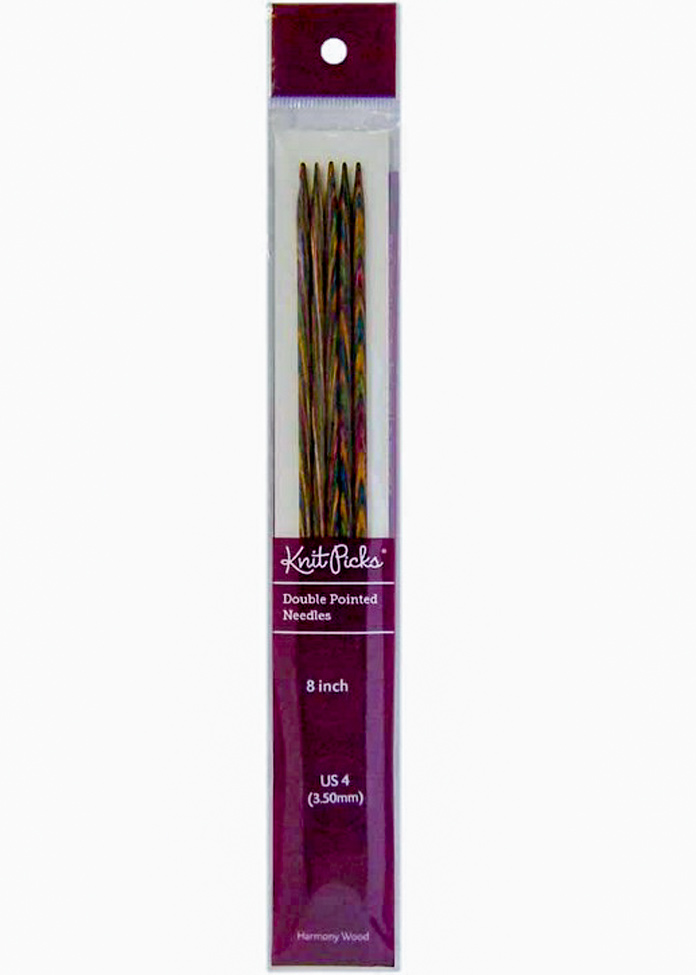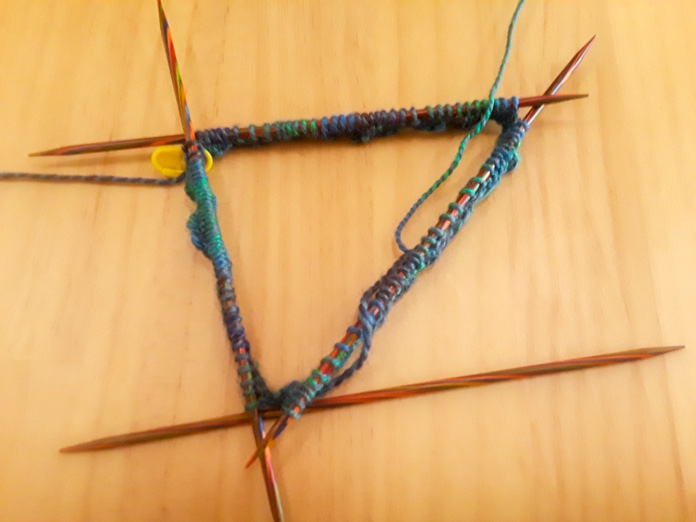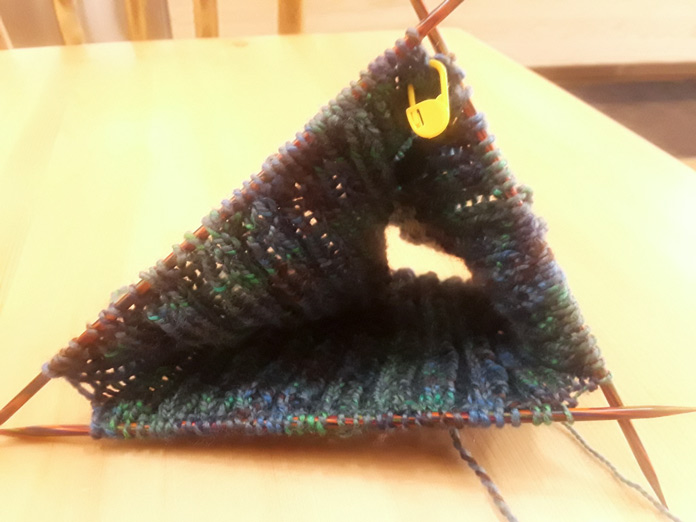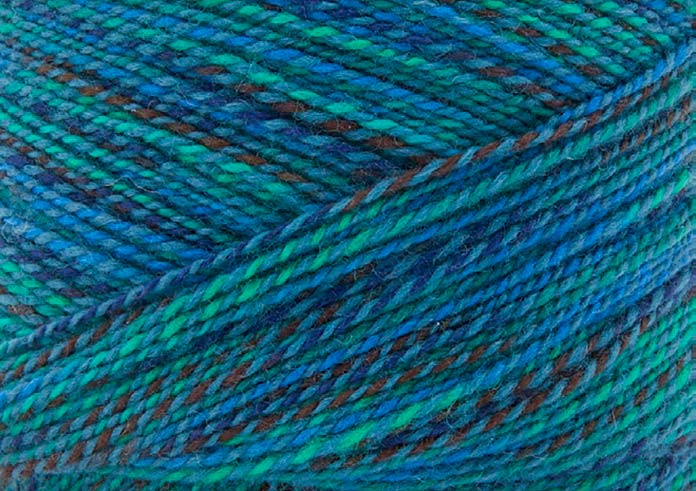Welcome back to the Gallinule Hat. I worked on Knit Picks 8-inch double-pointed needles in Fibra Natura Cobblestone Yarn. Yesterday was about casting on the Gallinule Hat by Rachel Brockman when using double-pointed needles.

A package of Knit Picks Wooden Double Pointed Needles
Today, I’ll talk about knitting the hat and how I make my life easier with over one hundred stitches on double-pointed needles—and I don’t use all five needles that came in the package!

The bottom edge of the Gallinule Hat, knit in Fibra Natura Cobblestone Yarn in Mallard.
A common question is, “But there are 5 needles in the pack. Why not use all five of them?” Now, there’s actually an answer to that, and it’s not just that the fifth needle is a spare.
When working with double-pointed needles, you always have the one needle you’re knitting with. So, when people talk about three needles when it comes to working with double points, they often mean that the knitting is on three needles, and you’re knitting with the fourth. But that 5th double-pointed needle isn’t just a redundant spare.
. . . ok, maybe it is, sort of. As with a lot of things in the world of knitting, the actual answer is “It Depends.” Double-pointed needles are, admittedly, somewhat annoyingly easy to lose, and if you’re working with 4 needles, it does mean that if you lose one, you do still have the spare. And yes, there’s even some science as to why you should have your knitting on three double-pointed needles rather than four. When you have your knitting on three needles, it forms a triangle. If you have your knitting on four needles, it forms a square. But, if you remember back to your science classes, triangles and pyramids are sturdier shapes than squares and rectangles. So, your knitting will flop around less and have more structure if you only have three needles instead of four.

The Gallinule Hat in progress, knit in Fibra Natura Cobblestone Yarn in Mallard on Knit Picks Double Pointed Needles.
Then why is that 5th needle in there if knitting with four needles is sturdier?
For many knitters, it’s often easier if your stitch repeat (especially for cables and lace), doesn’t get interrupted by having to switch needles. So, if the stitch count of your project isn’t divisible by three, your options are to either a) have your stitches unevenly distributed, which becomes a challenge for large stitch repeats, and makes working cables across where you have to switch needles incredibly difficult, or, b) have your stitch count divisible by four, and use four double-pointed needles to split your stitches evenly or, at least close to evenly. If your stitch count isn’t divisible by either three or four, that’s a rare thing for a pattern, and you can probably still distribute your stitches pretty close to evenly. For example, while I was working on this Gallinule Hat, my stitch distribution was 38 stitches on two needles and 36 stitches on the remaining needle – and a stitch difference won’t make much of a difference with the knitting process, plus, a two-stitch difference works out easily in the two by two ribbing.
A quick tangent here on the topic of stitch repeats – if using stitch markers to mark your stitch repeats, or the beginning and end of your round, be careful with ring stitch markers. They can fall off the ends of the needles! Instead, when working with double-pointed needles, I almost always use locking stitch markers like the UNIQUE Knitting Safety Stitch Marker because I don’t have to worry about losing a stitch marker off the end of my double-pointed needles.
Tangent completed, but still staying on the topic of geometry for a moment; one of the other advantages of having your knitting on four needles is that the square shape with four needles is easier to collapse down if you’re packing it into a project bag. The triangle shape with three needles won’t collapse down as nicely for storage and travel. That’s the disadvantage of it being a sturdier shape. So, having five needles makes a project easier to transport, which can be a consideration if you’re knitting on public transport or having to carry your project in a purse or bag.
Finally, there are many patterns and needle sizes where you simply can’t put all the stitches onto three needles. Even the Gallinule Hat pattern itself, as I mentioned yesterday, suggests double-pointed needles for all but the two smallest sizes, and it’s only because I specifically sought out the Knit Picks 8-inch Double Pointed Needles that I was able to fit all the stitches for the Adult Small size on three needles and knit with the fourth. If I were knitting this hat on 6-inch double-pointed needles, or if I were knitting the larger sizes, I would, in fact, need all five needles or have to switch to a circular needle.
So, sometimes, you do need all five needles to have enough space to hold and work the stitches, but why not simply switch to circulars at that point? Why choose five double-pointed needles over circulars?
The first answer is that anything that has a smaller circumference – things like hat crowns or the fingers of gloves – requires using either the Magic Loop or Travelling Loop techniques to knit on a circular needle. And, simply, not all knitters are familiar with these techniques – I spent the first 30 years of my knitting life not knowing the Magic Loop technique existed! In my early knitting days, circular needles were for sweater bodies and other big things, double-pointed needles were for things like socks and mittens, and that was just how it was!
The second answer is history. Circular needles are a comparatively new needle invention, really only coming into their own when nylon and plastics were invented to make the needle cord. The first circular knitting needles used steel wire for the cable, and this caused problems because the yarns would catch on the wire, but this didn’t stop knitters from jumping on this ‘new way’ of knitting. Conversely, double-pointed needles have been in use since at least the European Middle Ages, and before the invention of circular needles in the early 1900s, double-pointed needles were pretty much the only way to knit in the round. Indeed, you can still find vintage double-pointed needles that are much, much longer than modern double-pointed needles. I’ve seen vintage double-pointed needles 12 inches long and made for knitting sweaters! So, for many people, myself included, double-pointed needles are simply more familiar and more comfortable, even if they’re knitting on four needles – because that is what they learned.
This is one of the joys of the knitting world. There are many ways to knit things; it’s all about what you’ve learned and are comfortable with! I’ve met knitters who really don’t enjoy double-pointed needles, whereas I very much do, and both techniques work out just fine when it comes to an end result!
Honestly, as someone who knits a lot on double-pointed needles, my concern about this pattern wasn’t really the needles once I got the 8-inch ones; it was the Fibra Natura Cobblestone Yarn. The Mallard colorway is absolutely gorgeous, don’t get me wrong, but I was worried about how it would knit up in the pattern and if it would just look muddy and jumbled – and that’s a discussion for tomorrow’s blog post! Join me!

Fibra Natura Cobblestone Yarn in Mallard colorway is absolutely gorgeous!
This is part 2 of 5 in this series
Go back to part 1: How to cast on the Gallinule Hat pattern using double-pointed needles
Go to part 3: What to consider when knitting with variegated yarns
